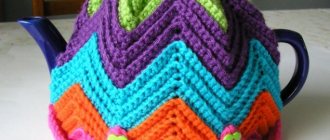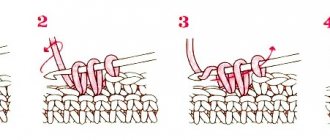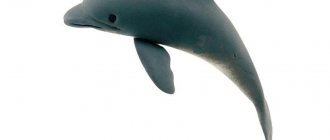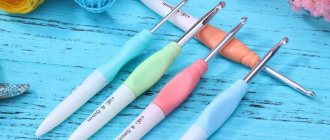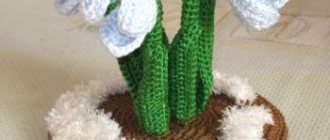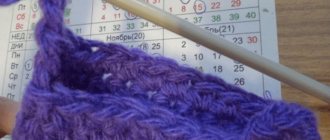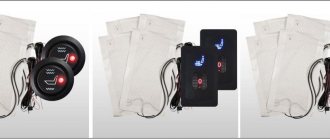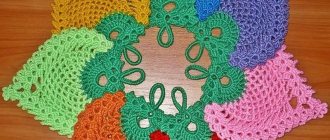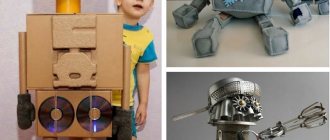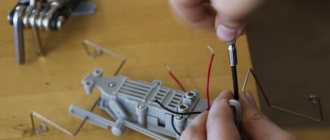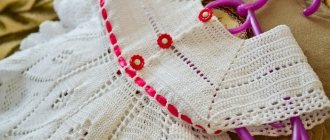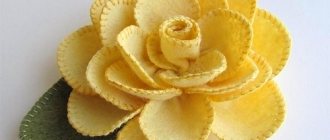Any thing made with your own hands is considered not only exclusive, but also “alive” because a piece of soul, warmth, and energy was sewn into every detail. Interesting toys Tilda cats, bunnies, bear cubs, chickens will decorate any home and will serve as a wonderful gift.
Creating a tilde with your own hands will not take much time, but the result will delight you for a long time. Many magazines and the Internet present a large selection of life-size tilde cat patterns; you can easily sew a toy with it.
Pattern of a fat hare tilde
To create a bunny toy, many needlewomen use a life-size tilde cat pattern, adjust the ears - enlarge them to the desired size, or take a ready-made bunny pattern.
The pattern is pressed tightly to the fabric, outlined with chalk, and allowances are taken into account when cutting. Sew along the drawn line; the places on the cat pattern marked with a dotted line are left unstitched; through them the parts are turned right side out. The next stage is to carefully iron all the seams. All parts are filled with filler so that each element is soft; you should not stuff it too tightly; the toy may tear. Next, the unstitched areas are carefully sewn by hand. All parts are assembled into one product. Sometimes clothing patterns for tildes of a cat, a hare and others are added to the main toy patterns.
It is not necessary to sew outfits according to the proposed patterns; you can come up with an original costume yourself.
Soft cats squishy
Anti-stress toys are very popular. You can not only play with them, but also decorate phone cases or notebooks. Making such crafts will bring pleasure to both adults and children.
- You will need a mold for a cat figurine. You can make it yourself. Take a piece of plasticine and form a thick cake. Then, using a stack with a round end, we squeeze out a rounded head at the top. Then we press down the oval tummy at the bottom. We make the tummy wider and deeper so that the cat turns out plump.
- Next we press out the triangular ears on the head, and draw the legs from below. From the head we make rounded handles. On the head we squeeze out a muzzle with a lower lip and nose. Then use a toothpick to press out the eyes of the strips.
- Take sunflower oil and pour it into a container. Add silicone sealant. Mix thoroughly. We wear gloves. The better the silicone and oil are mixed, the softer the toy will be after hardening. Without oil, the silicone will remain stiff and hard.
- Fill the mold with the resulting mixture and smooth the surface so that there are no gaps left.
- To make a colored cat, add acrylic paint of the desired color to the silicone and mix. Let it harden for 8-12 hours.
- Then we take out the cat. It comes out of the mold easily. The oil will make the figurine very greasy, so you need to roll it in talc to dry it. You can use starch instead of talc.
- Using scissors, we cut off all the excess edges to get an even and beautiful cat.
- We color the figurine. Silicone can only be painted with silicone. Mix acrylic paints with sealant. You will need black, white, pink. We paint the ears, eyes, muzzle. You can draw a spot on the tummy or tail. Let the silicone harden for a couple of hours.
The anti-stress squishy toy is ready!
Tips for using tilde patterns
Before you take the tilde cat pattern, cut the fabric and sit down at the sewing machine, you should read the recommendations of people who have experience in sewing tilde, perhaps many tips will help you avoid problems when creating a toy, while others will encourage you to create, for example, clothes for cats, interesting registration
All seams are made only from the wrong side, otherwise the toy will look sloppy.
It is necessary to leave allowances along all seams; if you are sewing a garment for the first time, it is recommended to leave 0.5 cm, for more experienced ones - 0.3 cm. If the allowance is large, at the end of the work the excess fabric is cut off, leaving 0.3 cm to the seam.
From all the variety of types and forms of tildes, choose the one you like best, they have almost the same complexity. The tilde cat pattern can be downloaded from the Internet, which opens up the opportunity to adjust the size of the future toy. Using graphic editors on a computer, you can enlarge, compress, or stretch the pattern to the required size.
Material for cats and their clothes are washed and ironed before cutting.
You should strictly follow all the recommendations for the pattern, tucks, darts, they must be laid as indicated, otherwise when assembling the toy, the joints may not match.
When sewing a cat with your own hands, in places where parts have a fold, in rounded places, you should make notches in the allowance, this allows you to avoid the formation of folds and irregularities.
The finished part is turned inside out using a long object with a blunt rounded end (pencil, pen); if you take a pointed long object, you can tear the fabric.
For the filler, choose one material for all parts; it has proven itself well for these purposes - padding polyester, padding polyester, alpolux, holofiber.
When decorating the face, choose small black beads for the eyes, and dark embroidery threads for the nose and mouth. In principle, the face can be drawn with a thin black marker or fabric paint.
Applications
Paper is a material that is easy to cut, bend, and glue. A master class video will help you make an applique of an original paper cat.
Another option is appliqué using pieces of fabric.
For work you will need the following materials and tools:
- foam base 3 cm thick, size 50x80 cm;
- multi-colored pieces of fabric;
- marker;
- scissors, manicure file, stationery knife.
A cat is drawn on the base sheet; you can use a stencil. All details are cut with a stationery knife.
A piece of fabric is cut out a little larger in size than the applique piece, placed on top of the design and carefully tucked into the slots with a nail file. The edges are secured with glue.
Two-legged cat tilde
It is an excellent option for those who are afraid to start sewing. The cat pattern is simple, even a child can do it.
All parts are paired, except for the nose. They cut, sew, and in all tilde-style patterns leave an unsewn space for turning and filling.
To obtain a neat nose, the part is pulled together at the edges, forming a “bag”, filled with stuffing, the threads are tightened, and the part is closed. Sewn to the head. Unlike a standing cat, the tilde two-toed cat does not stand; it is usually hung on a hook or door handle.
Beads are sewn on the eyes with black thread and a mustache is embroidered. At the stage of designing the face, you need to show your imagination - eyes, nose, mustache can be made whatever you want, to suit every taste.
Nature comes to the rescue
When walking through the forest with your children and stocking up on a variety of cones - spruce and pine, it is convenient to come up with a figurine in advance. The cat craft from pine cones is made by connecting individual pieces, sticking oppositely directed shoots into each other.
Plasticine additions in the form of ears, cheeks, and eyes will serve as an aesthetic design. The tail can be attached with wire or thread, from a braided cord.
You can make a cat craft:
- Made from potatoes, equipped with plasticine paws, ears and eyes, mustaches made from fishing line;
- From a pumpkin ripened in the garden and picked. To make a cat, you need to put one fruit next to another, imitating the head and body, attach whiskers, paws and a tail. The orange color of the pumpkin is quite suitable for reproducing the red color;
- From coffee beans or beans glued to cardboard;
- From a red or white onion. If you bend the small single-layer inserts, you get ears. The eyes can be made as if they were closed, by cutting them with a knife in the right places in the form of semicircles;
- Made from acorns and chestnuts, complemented with plasticine details.
Pattern of a fat cat tilde
A fairly simple product to make, well suited for beginner needlewomen. The cat pattern is adjusted to the desired size of the future toy. Patterns are cut out of thick paper.
The pattern is transferred to the wrong side of the fabric, seam allowances are taken into account, and cut out. When sewing a cat, they start with paired parts, iron them, fill them with filler, and carefully sew open areas by hand. Collecting a toy. You can complement the cat tilde with various items and homemade decorations.
Fluffy kitty
Required materials: colored paper, a sheet of white cardboard, PVA glue and ordinary cotton wool.
On a colored sheet we draw the outlines of the cat. You can print it on a printer or draw it by hand. You don’t have to draw a classic cat; your craft can look like a cartoon character or a children’s book. Cut out along the contour and glue the figure onto a white sheet of cardboard.
Now we will make a fluffy fur coat. Lubricate the silhouette of the cat with glue, stepping back 1 cm from the edge. Tear off pieces of cotton wool and glue them, creating volume. Finally, we decorate the face: glue on the eyes and nose.
In order to make a beautiful cat craft, you do not need expensive materials or special skills. The time spent on making will not be wasted and will bring a lot of pleasure.
Master class on making tilde cats
When cooking, the toy looks very cute, pleasant to the touch, and will serve as a wonderful addition to the interior. A small master class will help you create crafts.
The tilde cat pattern consists of a small number of parts.
To sew a toy you will need: basic plain fabric, colored fabric for clothes, lace, ribbons, black beads for the eyes, black fishing line for the mustache, dark threads, 4 buttons to match the main material, filling.
Cut out a paper pattern from thick paper or cardboard. The cat pattern is transferred to fabric folded in half, secured with needles and outlined with chalk. Taking into account seam allowances, cut out. They begin work on assembling the toy from the head, sew it together, leaving a small hole unsewn for turning it inside out and fill it with filler, after which the hole is sewn up by hand. The same operation is carried out with the ears.
A distinctive feature of this Tilda cat doll toy is that all its legs move as if on hinges. This effect is achieved in this way: using buttons, the legs are sewn to the body, poking it right through, and the upper or lower legs are sewn at the same time.
The tail is made similarly to other parts, sewn to the back of the body.
The eyes are decorated with beads or simply painted, the nose is embroidered with thread, the cheeks are painted with special fabric paints, the antennae are drawn with fishing line, pulled through the muzzle, their length is limited only by imagination.
The way to make a dress pattern for a cat is to measure the required length and width of the dress from the doll. A rectangle is drawn on paper based on the data obtained. At this stage, you should reduce the top part of the dress - you get a trapezoid. Transfer the pattern to colored fabric, cut out two parts and fold them face to face, sew them together with your own hands or on a machine, leaving holes for the arms and head. A hole is made for the tail using scissors. Decorate the dress with lace, ribbons, bows. Tilda is ready.
Implementation of creative ideas from paper
To make easy cat crafts, just take sheets of colored paper and scissors.
The application will help to depict:
- Figured silhouette/profile of a cat sitting on a roof looking at the moon;
- An image assembled like a puzzle, from triangles and squares folded in the shape of a cat;
- A multi-colored cat with a red (orange) head, a striped body, and a black tail.
Paper crafting includes the art of quilling and origami, including modular and papercraft. A cat made of corrugated curls will find its rightful place on the sheet.
A voluminous pussy, obtained by folding individual sheets, looks good as a decoration for a child's room.
A paper cat craft can be glued together from individual pieces in the form of a box with legs. If you cover the top of the resulting shape with fleecy fabric or fur, make eyes from beads and a tail from lace, such a figurine will be no different from a hand-made creation.
Selection of schemes
#462 Salomon
Materials
Soft, pleasant materials are the key to the toy’s popularity. Your baby won’t go to bed with a cat made of genuine leather, but a keychain made from this material will last longer than a rag one:
- Fleece and fur. Frequently used materials are similar to animal fur - fur and fleece. The latter option is budget-friendly, affordable, has many shades and is easy to sew.
- Felt. Felt is often used to make flat crafts, such as a refrigerator magnet or a panel.
- Calico, chintz, cotton, linen. Simple fabrics such as chintz and calico make cool Scops Owls dolls.
- Other materials. Other fabrics, construction or waste materials are also used in the work. For example, burlap or laminate backing.
